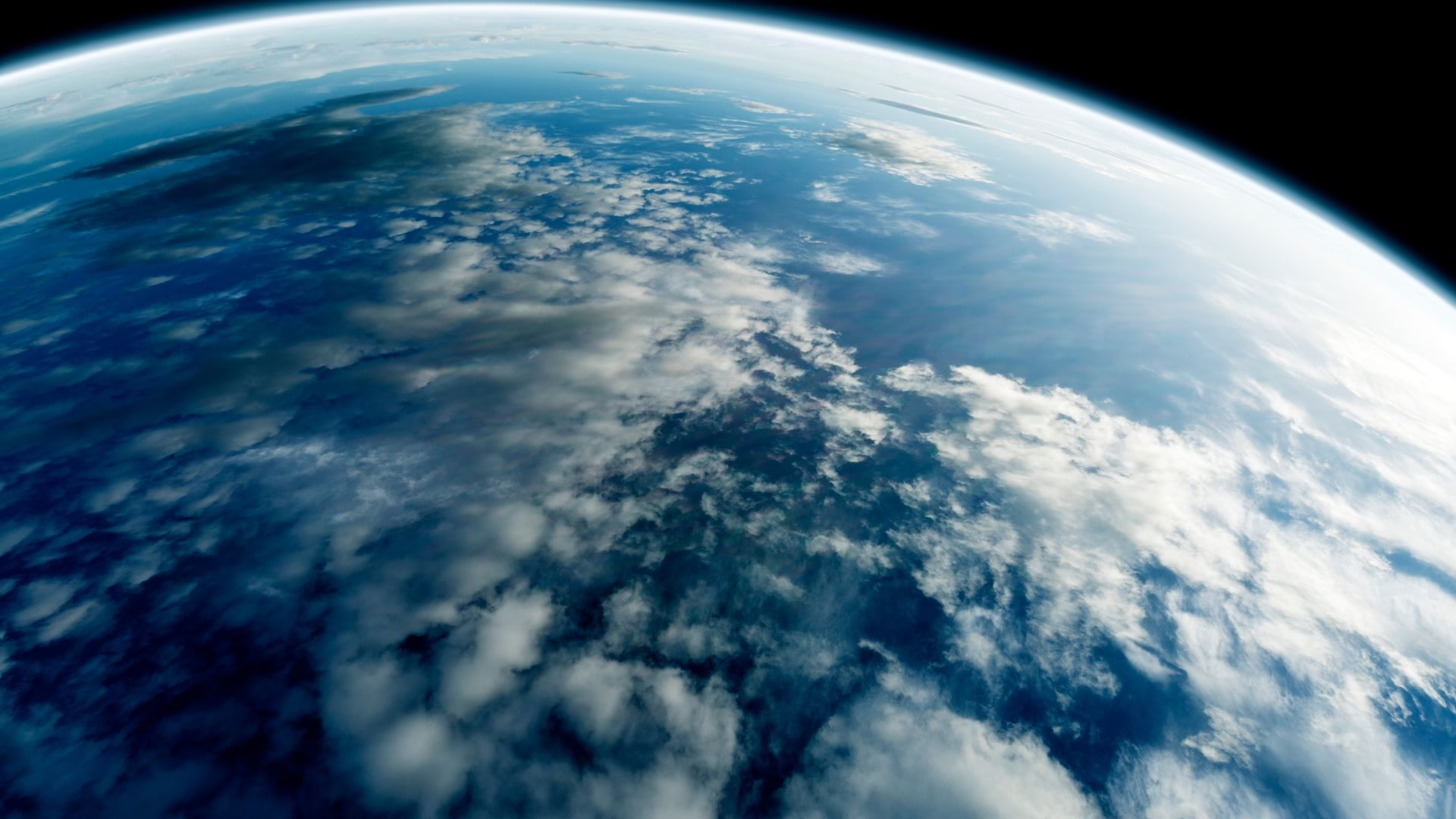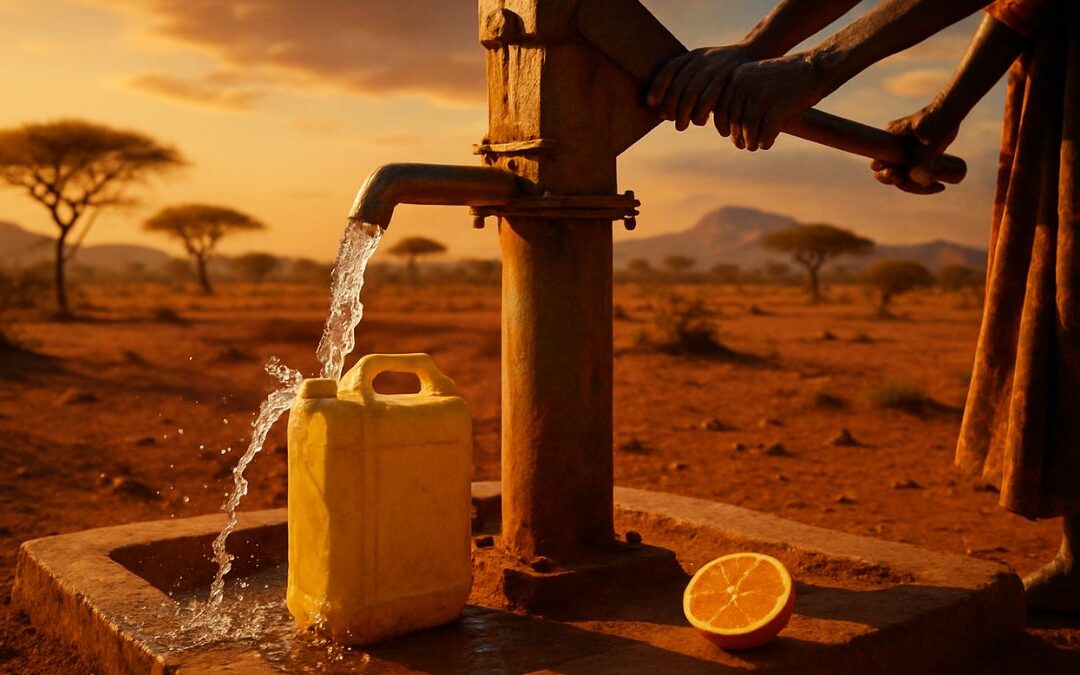- Introduction: More Than Just Air Above Us
- The Troposphere: Where Weather Happens
- The Stratosphere: Home of the Ozone Shield
- The Mesosphere: The Fiery Gatekeeper
- The Thermosphere: The Edge of Space
- The Exosphere: The Final Frontier
- Why Earth’s Atmosphere is a Cosmic Miracle
- Conclusion: Protecting Our Protective Blanket
- Let’s Talk
- Let’s Learn Vocabulary in Context
- Let’s Discuss & Write
- Danny Answers the Discussion Questions
- 1. If Earth suddenly lost its atmosphere for 10 minutes and then got it back, what do you think would be the immediate consequences?
- 2. We often talk about space exploration, but do you think we should focus more on protecting Earth’s atmosphere instead of trying to colonize other planets?
- 3. The ozone layer was nearly destroyed by human activity, but global efforts helped repair it. Do you think we could do the same for climate change, or is it too late?
- 4. If you could travel to any layer of the atmosphere for a day, which one would you choose and why?
- 5. Do you think life could exist on another planet without an atmosphere like Earth’s? What would it take to make that possible?
- Danny Writes the Assignment
- Let’s Play & Learn
Introduction: More Than Just Air Above Us
From the moment we take our first breath, we owe our existence to an invisible yet powerful force—the Earth’s atmosphere. This multilayered shield does far more than provide the oxygen we need to survive. It regulates temperature, shields us from harmful radiation, and prevents space debris from turning our planet into a cosmic battlefield. Without it, Earth would be an inhospitable rock adrift in the void.
But what exactly makes up this atmospheric armor? The atmosphere is divided into five primary layers, each with distinct characteristics and roles. From the weather-making troposphere to the mysterious exosphere where the air thins into space, let’s journey through the different atmospheric layers and uncover their secrets.
The Troposphere: Where Weather Happens
- Altitude: 0 to ~12 km (0 to ~7.5 miles)
- Temperature Trend: Decreases with altitude
- Key Features: Clouds, storms, weather patterns, breathable air
The troposphere is the lowest and most familiar layer of the atmosphere—it’s where we live, breathe, and experience weather. Whether it’s a sunny afternoon, a torrential downpour, or a violent hurricane, all meteorological activity occurs here. This is because the troposphere contains approximately 75% of the atmosphere’s total mass and nearly all of its water vapor.
The air here is densest at sea level, which explains why oxygen becomes scarce at high altitudes, making mountaineering without supplemental oxygen a risky endeavor. As one ascends through the troposphere, temperatures steadily drop, leading to the subzero chill at the summit of Mount Everest.
At its upper boundary, the tropopause, temperatures stabilize, marking the transition to the next layer—the stratosphere.
The Stratosphere: Home of the Ozone Shield
- Altitude: ~12 to ~50 km (~7.5 to ~31 miles)
- Temperature Trend: Increases with altitude
- Key Features: Ozone layer, jet streams, minimal weather activity
Above the chaotic, weather-ridden troposphere lies the stratosphere, a relatively calm region that hosts the vital ozone layer. The ozone layer acts as Earth’s sunscreen, absorbing the sun’s harmful ultraviolet (UV) radiation and preventing it from reaching the surface in deadly doses. Without it, life as we know it would be impossible.
Interestingly, temperature increases with altitude in the stratosphere, contrary to what happens in the troposphere. This is because the ozone layer absorbs solar radiation, warming the surrounding air. This temperature inversion creates a stable atmospheric region where commercial jets prefer to cruise, avoiding turbulence from lower weather disturbances.
However, human activities have historically threatened the stratosphere’s integrity. The release of chlorofluorocarbons (CFCs) led to ozone depletion, famously creating the Antarctic ozone hole. Thankfully, global agreements like the Montreal Protocol have helped curb ozone destruction, showcasing humanity’s ability to reverse atmospheric damage.
The Mesosphere: The Fiery Gatekeeper
- Altitude: ~50 to ~85 km (~31 to ~53 miles)
- Temperature Trend: Decreases with altitude
- Key Features: Meteor burn-up, coldest layer of the atmosphere
The mesosphere is often called the “graveyard of meteors” because this is where most space rocks meet their fiery demise. When meteoroids enter Earth’s atmosphere, friction with the air in this layer causes them to burn up, creating the streaks of light we recognize as shooting stars.
Despite this dramatic role, the mesosphere remains one of the least understood layers. It’s too high for weather balloons and too low for satellites, making direct measurements challenging. However, one thing we do know: it is the coldest part of Earth’s atmosphere, with temperatures plunging to a bone-chilling -90°C (-130°F).
At its upper boundary, the mesopause, the atmosphere transitions to the thermosphere, where conditions become strikingly different.
The Thermosphere: The Edge of Space
- Altitude: ~85 to ~600 km (~53 to ~373 miles)
- Temperature Trend: Increases dramatically with altitude
- Key Features: Aurora borealis, space station orbit, extreme temperatures
The thermosphere is where things start getting weird. Although technically part of Earth’s atmosphere, this region blurs the line between atmosphere and outer space. It’s also where some of the most stunning celestial light shows—the auroras—occur.
When charged particles from the sun collide with gases in the thermosphere, they excite atoms, causing them to emit the vibrant aurora borealis (Northern Lights) and aurora australis (Southern Lights). This layer is also home to the International Space Station (ISS) and numerous satellites, which orbit the Earth in its relatively stable conditions.
Temperature-wise, the thermosphere is an enigma. It can reach up to 2,500°C (4,500°F), but because the air is so thin, heat transfer is negligible. This means that if an astronaut were floating here without a spacesuit (which is a bad idea for several reasons), they wouldn’t actually feel that scorching heat.
The Exosphere: The Final Frontier
- Altitude: ~600 km to ~10,000 km (~373 to ~6,200 miles)
- Temperature Trend: Gradual fade into space
- Key Features: Satellites, transition to outer space
The exosphere is the ultimate atmospheric fade-out zone, where air becomes so sparse that it seamlessly transitions into the vacuum of space. Here, molecules can travel hundreds of kilometers without colliding with one another, making it vastly different from the air we breathe.
This is the realm of satellites, which can orbit the planet without significant atmospheric drag. Beyond this layer, Earth’s atmosphere officially gives way to interplanetary space, and gravity’s influence weakens.
Why Earth’s Atmosphere is a Cosmic Miracle
Earth’s atmospheric layers work in harmony to support life, regulate climate, and protect us from extraterrestrial hazards. Compared to our celestial neighbors, we’re incredibly fortunate:
- Venus has a thick, toxic atmosphere that traps heat, creating a hellish greenhouse effect.
- Mars has a paper-thin atmosphere that can’t support liquid water or shield against radiation.
- The Moon has no substantial atmosphere at all, leaving its surface exposed to brutal temperature swings and cosmic radiation.
Our atmosphere is a rare, dynamic system that makes life possible—a fact we often take for granted.
Conclusion: Protecting Our Protective Blanket
As much as the atmosphere protects us, it is not indestructible. Climate change, pollution, and ozone depletion threaten its delicate balance. Understanding how Earth’s atmospheric layers function is not just an academic exercise; it’s a call to action.
By reducing emissions, protecting the ozone layer, and minimizing pollution, we can help preserve the invisible shield that makes life on Earth possible. After all, it’s not just air—it’s our lifeline to the cosmos.
Let’s Talk
So, let’s talk about Earth’s atmospheric layers. I mean, it’s kind of wild when you think about it—we’re walking around, going about our lives, completely dependent on an invisible protective blanket that we can’t even see. It’s just there, doing its job without demanding attention, like the unsung hero of our existence. But let’s be real—do we actually appreciate it?
We talk about oxygen because, well, breathing is kind of important, but what about the rest? Have you ever stopped to thank the mesosphere for making sure you don’t get smacked in the face by a flaming rock from outer space? Or the thermosphere for putting on a dazzling aurora light show just because the Sun decided to throw some charged particles our way? And let’s not forget the exosphere—floating up there, minding its own business, making sure satellites don’t crash into each other (too often, at least).
But here’s the thing: we often take this whole setup for granted. We act like Earth’s atmosphere is some unbreakable force field, but it’s actually pretty delicate. For instance, we almost ruined the ozone layer because we just had to have hairspray that could hold up in a hurricane. Imagine explaining that to an alien: “Oh yeah, we almost cooked ourselves with UV radiation because we needed big 80s hair.” Thankfully, we got our act together with the Montreal Protocol, proving that humans can fix things when we actually try. But that was just one layer, and there’s still a whole lot more to protect.
And speaking of taking things for granted—what if we didn’t have this atmosphere? Ever thought about what life would be like without it? Let’s just say, you wouldn’t be here. You’d either be incinerated, frozen solid, suffocated, or bombarded with cosmic radiation, depending on which horror show you prefer. Look at the Moon—it has no atmosphere, and it goes from boiling hot to freezing cold within hours. Mars? Its atmosphere is so thin that it can’t even keep liquid water on its surface. Venus? Oh, Venus went too far in the other direction—thick, toxic atmosphere with a runaway greenhouse effect that turned it into a planetary pressure cooker.
But let’s bring this back down to Earth—literally. Why does any of this matter in our daily lives? Well, if you’ve ever flown in a plane, you’ve personally benefited from the stratosphere’s stability. If you’ve ever used GPS, you owe a thank-you to the exosphere for keeping satellites in orbit. And if you’ve ever enjoyed a warm summer breeze instead of a blistering -90°C gust of mesosphere-level cold, well, that’s because the troposphere has your back.
And yet, we humans love pushing our luck. We mess with the atmosphere by burning fossil fuels, releasing pollutants, and chopping down trees like we have a backup Earth just lying around. The atmosphere is great, but it’s not an unlimited resource—it’s a delicate, dynamic system that responds to what we do. And when it changes—whether that’s in the form of climate shifts, increased storm intensity, or worsening air quality—it’s not just some distant problem for “future generations.” It’s happening now.
So here’s a question: when was the last time you thought about the air you breathe? Not just the quality, but the fact that it even exists? Maybe next time you step outside, take a deep breath and remember that you’re standing inside an invisible force field that’s shielding you from the chaos of space. And maybe—just maybe—we should start treating it with a little more respect.
Let’s Learn Vocabulary in Context
Let’s dive into some words and phrases from our atmospheric adventure—because if we’re going to talk about the atmosphere, we might as well sound smart while doing it.
First up, invisible shield—this one’s fun because it sounds like something straight out of a superhero movie. But in this case, it’s just a fancy way of describing the atmosphere’s role in protecting us from space dangers. You could use it metaphorically too—like, “Coffee is my invisible shield against Monday mornings.”
Then we have turbulence—if you’ve ever been on a plane and felt that unsettling jolt, congratulations! You’ve experienced turbulence. It happens when different air currents clash, usually in the troposphere. You can also use it metaphorically, like when your personal life is going through some turbulence (hopefully without the fasten seatbelt sign coming on).
How about ozone layer? Now, the ozone layer is like Earth’s sunscreen, protecting us from ultraviolet radiation. But here’s a tip: don’t mix it up with the ozone smell you get after a lightning storm—that’s ozone too, but it’s not the same thing. So, next time you smell that fresh, stormy air, you can casually say, “Ah, the scent of atmospheric chemistry.”
Speaking of cool atmospheric things, let’s talk aurora borealis—which sounds mystical but is really just charged solar particles colliding with gas in the thermosphere. And no, despite all the memes, you can’t see it from your kitchen window unless your kitchen happens to be in Norway.
Next, meteor burn-up—this happens in the mesosphere, where space debris meets its fiery doom. In everyday use? “My patience burned up like a meteor when my Wi-Fi went out mid-show.”
Now, onto gradual fade—used to describe how the exosphere fades into space, but also useful for when someone tries to ghost you without making it obvious.
We can’t forget heat transfer, which determines how temperatures behave in different layers. Fun fact: the thermosphere is thousands of degrees hot, but because air molecules are so spread out, you wouldn’t actually feel that heat. Sort of like how some people have thousands of social media followers but no real interactions—plenty of energy, but no real transfer.
Then we’ve got runaway greenhouse effect, which is basically what happened on Venus when it trapped too much heat. Use this in real life when describing any situation that escalates quickly—like “I started watching one episode, and suddenly I was eight seasons deep in a runaway greenhouse effect of binge-watching.”
And finally, cosmic radiation—sounds intense, right? It’s the high-energy particles from space that our atmosphere protects us from. In daily life, it could be your excuse for anything: “Why am I late? Cosmic radiation interference.” Okay, maybe that won’t fly with your boss, but it’s worth a try.
Let’s Discuss & Write
Discussion Questions:
- If Earth suddenly lost its atmosphere for 10 minutes and then got it back, what do you think would be the immediate consequences?
- We often talk about space exploration, but do you think we should focus more on protecting Earth’s atmosphere instead of trying to colonize other planets?
- The ozone layer was nearly destroyed by human activity, but global efforts helped repair it. Do you think we could do the same for climate change, or is it too late?
- If you could travel to any layer of the atmosphere for a day, which one would you choose and why?
- Do you think life could exist on another planet without an atmosphere like Earth’s? What would it take to make that possible?
Writing Prompt:
Imagine you are an astronaut on a space station, observing Earth’s atmospheric layers from above. Write a short journal entry describing what you see and how each layer plays a role in keeping life safe on Earth.
Tips for Writing:
- Start by describing what the Earth looks like from space—what colors do you see?
- Talk about each layer from an astronaut’s perspective—how do they change as you look down?
- End with a reflection—how does seeing the atmosphere from space make you feel about life on Earth?
Now, go forth and appreciate the air around you!
Danny Answers the Discussion Questions
1. If Earth suddenly lost its atmosphere for 10 minutes and then got it back, what do you think would be the immediate consequences?
Oh, this is fun. Well, by fun, I mean absolutely terrifying. If Earth’s atmosphere just vanished for 10 minutes, we’d have some serious problems—immediately. First, without air pressure, all the oxygen in our blood would bubble out, meaning everyone not in a pressurized environment (so, uh, all of us) would pass out within seconds. Water would start boiling at body temperature, which is as horrifying as it sounds. Birds would drop from the sky, planes would fall out of the air, and every single body of water—oceans, lakes, even that glass of water on your desk—would start evaporating into space.
And the temperature? Instant deep freeze. Without the atmosphere to trap heat, the planet would suddenly experience the same kind of heat loss that makes the Moon go from boiling to freezing in a matter of hours.
Now, assuming the atmosphere magically reappeared exactly as it was, would we all just stand back up, dust ourselves off, and continue scrolling through social media? Not quite. The sudden reintroduction of air would likely cause hurricane-force winds, massive temperature shifts, and some serious chaos. Also, a lot of things—living and non-living—would have already been exposed to the brutal vacuum of space. Not to be dramatic, but we’d be looking at a pretty grim survival rate.
Moral of the story? Let’s not misplace the atmosphere. It’s kind of important.
2. We often talk about space exploration, but do you think we should focus more on protecting Earth’s atmosphere instead of trying to colonize other planets?
Look, I love space. It’s vast, mysterious, and full of potential. But let’s be real—we have this beautiful, life-sustaining planet right here, and we’re treating it like an old phone charger, just assuming we can toss it out and get a new one when it stops working.
The idea of colonizing Mars is cool and all, but Mars is not, I repeat, not, a good backup plan. It has no breathable air, no liquid water (unless you count underground ice), and its atmosphere is so thin that it offers zero protection from radiation. You’d step outside and immediately get hit by enough cosmic rays to make a microwave jealous. The amount of technology we’d need to survive on Mars—let alone thrive—is mind-blowing.
Meanwhile, Earth already has an atmosphere that regulates temperature, shields us from radiation, and literally provides us with air to breathe. Should we explore space? Absolutely! But we should put way more effort into protecting the planet we already have. Because if we can’t take care of Earth, what makes us think we’d do any better on Mars?
3. The ozone layer was nearly destroyed by human activity, but global efforts helped repair it. Do you think we could do the same for climate change, or is it too late?
Good news: We’re not too late. Bad news: We don’t have the luxury of time.
The ozone layer situation was kind of like catching a disease early—you get the diagnosis, you take action (in this case, banning CFCs), and over time, the body (or atmosphere) starts to heal. Climate change is a much trickier beast because it’s not just one problem—it’s a tangled mess of carbon emissions, deforestation, ocean acidification, and melting ice caps, all reinforcing each other like the worst domino effect ever.
But here’s the hopeful part: We know what’s causing it, and we know what needs to be done. Renewable energy, carbon capture, reforestation—these aren’t science-fiction ideas. They exist, they work, and we’re already seeing some countries making significant progress. The challenge is getting global cooperation and scaling up efforts fast enough to keep things from spiraling out of control.
So, is it too late? No. But we’re at that point where if we don’t slam the brakes now, we might not be able to stop the crash.
4. If you could travel to any layer of the atmosphere for a day, which one would you choose and why?
Ooooh, great question. I’d say the thermosphere, hands down. Why? One word—auroras.
Imagine floating up there, watching the Northern Lights swirl around you from above, while satellites drift by like silent cosmic spectators. It’s also where the International Space Station orbits, so you’d get some breathtaking views of Earth without actually leaving Earth. You’d technically be in the atmosphere, but it would feel a lot like being in space.
The only downside? The temperature can hit thousands of degrees. But since heat transfer doesn’t really happen up there (because air molecules are too spread out), you wouldn’t feel it. Which is weird. But weird in a cool way.
So yeah, sign me up for a day trip to the thermosphere. Just let me pack a space suit first.
5. Do you think life could exist on another planet without an atmosphere like Earth’s? What would it take to make that possible?
Life as we know it? Not a chance. Every form of life on Earth depends on the atmosphere in some way. Without an atmosphere, there’s no air, no pressure, no protection from radiation—basically, nothing that makes life livable.
Now, could there be some kind of life that evolved to survive in those conditions? Maybe. Extremophiles (those tiny, tough microbes that thrive in crazy environments) already live in some of Earth’s most inhospitable places—like deep-sea hydrothermal vents and acidic hot springs. If life does exist somewhere like Mars, it’s probably buried underground, where it’s shielded from radiation and has access to frozen water deposits.
But if we wanted to live on a planet with no atmosphere? We’d have to bring our own—a closed, self-sustaining system with oxygen, temperature control, and radiation shielding. Think giant space domes, underground colonies, or even artificial magnetic fields to replicate Earth’s protection. Possible? Sure, in theory. But practical? Not really, at least not with current technology.
Honestly, it’s easier to just take care of Earth. The atmosphere we have here is already perfect—no space domes required.
Danny Writes the Assignment
Journal Entry from a Space Station: Observing Earth’s Atmosphere
Date: Stardate… just kidding. February 3, 2025
Location: Aboard the ISS, 408 kilometers above Earth
I wake up to the silent, weightless world of the space station, but my eyes immediately drift to the view outside. Earth spins below me, a blue and white marble wrapped in a delicate swirl of clouds. It’s breathtaking. But what fascinates me most isn’t the land or the oceans—it’s the atmosphere. That thin, glowing halo hugging the planet is the only thing keeping everything down there alive.
From up here, it looks so fragile. I can see the soft gradient where the deep blue of the troposphere fades into the blackness of space. That’s where all life happens—where people are laughing, working, fighting, dreaming—completely unaware that just above them, the air begins to thin into an uninhabitable void.
As my eyes scan upward, I think about how each layer of the atmosphere plays its role. The stratosphere is like a silent guardian, absorbing harmful UV rays and keeping everything below from being scorched. The mesosphere, invisible yet mighty, stands as a shield against meteors that would otherwise bombard the planet. And the thermosphere—ah, that’s where the auroras dance. I wish I could see one from this vantage point. I imagine it would look like Earth itself is exhaling light into the cosmos.
I wonder, does anyone down there truly grasp the importance of this atmospheric blanket? Probably not—not until something threatens it. It’s strange how we rarely appreciate the things that sustain us the most. From here, it’s painfully obvious how delicate it all is. The air pollution, the thinning ozone, the rising temperatures—they aren’t just statistics. I can see them from here, the smog creeping over cities, the ice caps shrinking year by year.
The Earth is astonishingly beautiful, but from this height, it also looks… vulnerable. We live in a world encased in a thin shield of gases, a shield we can’t afford to damage. And yet, we do. Maybe if everyone could see Earth from up here, they’d understand how much we’re risking.
A soft beep from the intercom reminds me it’s time for my next scheduled task. I take one last glance at the planet spinning below me and whisper a silent promise: I’ll do my part to protect you.
I hope the people down there will too.










0 Comments